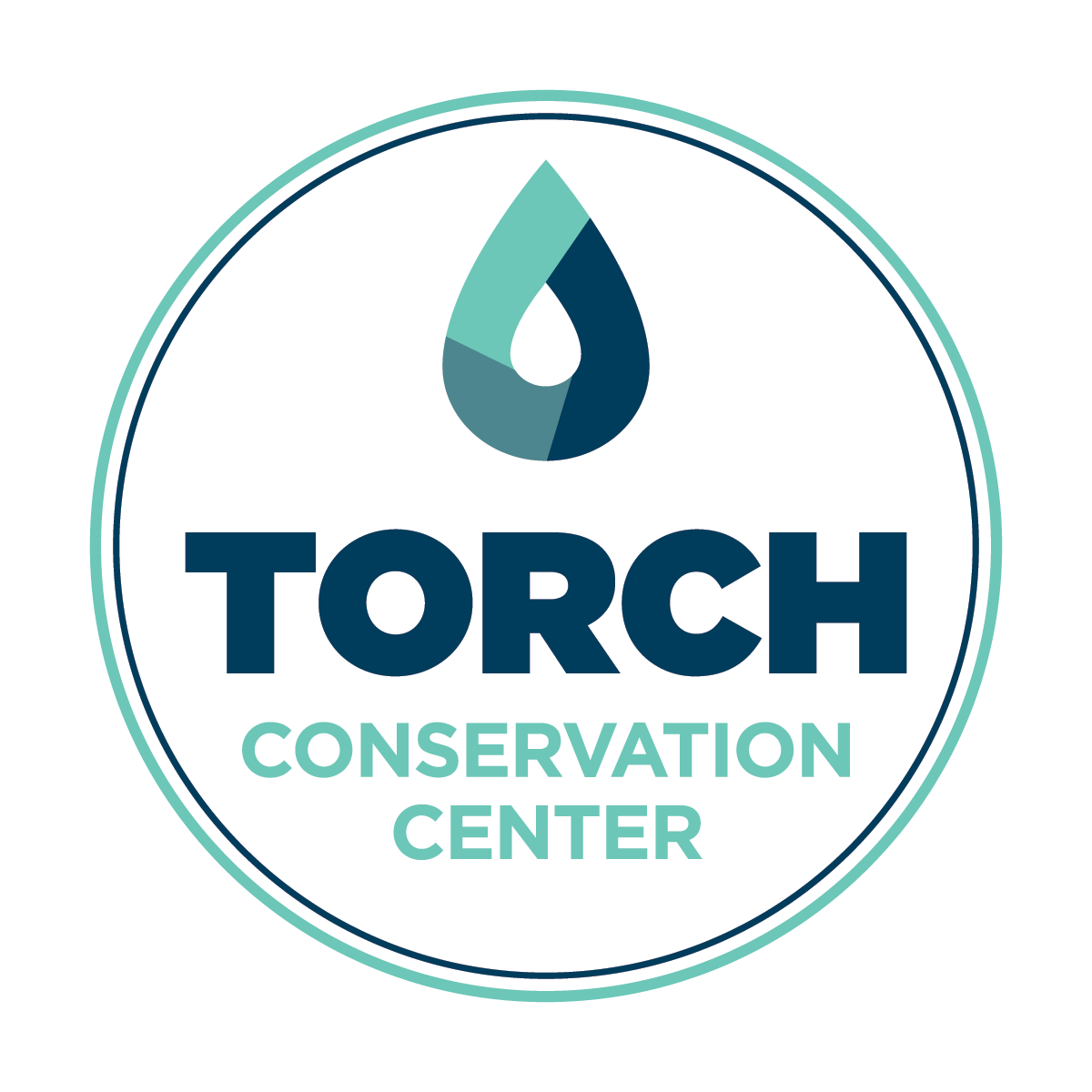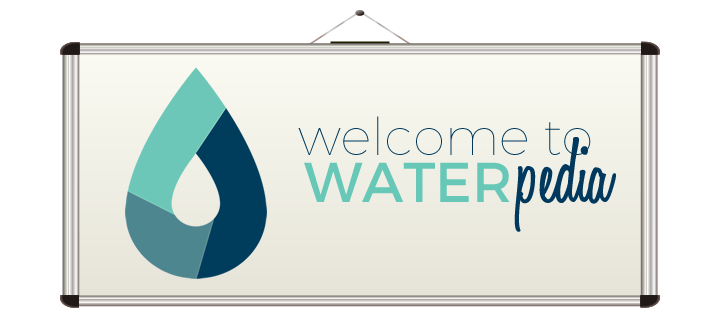
Microplastics
Key Facts
Microplastics are detrimental to birds, fish and aquatic life and possibly to humans.
Microplastics are small pieces of plastic about the size of a sesame seed, 1/5 inch wide.
Microplastics consist of broken-down fragments of plastic, microbeads and microfibers.
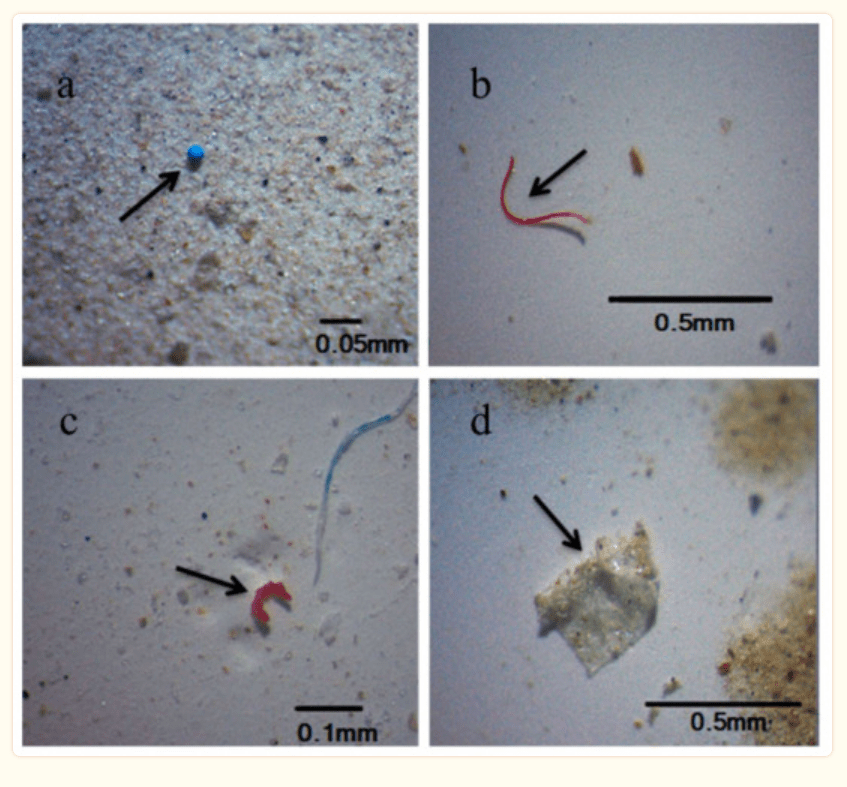
Microplastics: a. microbead or pellet b. microfiber c. fragment d. film. Photos: Gambino et al. 2020
In 2016, Americans generated the largest amount of plastic waste of any country in the world. (Law et
al. 2020)
Single-use plastic makes up about 40% of the plastic produced. (Parker, 2019)
Single-use plastic goods are:
- Made from fossil fuels-petroleum chemicals
- Used once and disposed of right after use-often within minutes
- Used for packaging (grocery bags, small baggies, bottles, plastic film, trays) and food service (bowls, plates, cups, lids, stir sticks, spoons, forks, knives, straws and takeout food containers)
About 5% of this plastic waste is recycled and 12% is burned as low-grade fuel. (Enck and Dell, 2022)
Most plastic waste ends up in landfills or illegally dumped as litter.
Fragments of Larger Plastic Goods
Plastics degrade over time but never go away.
An estimated 92% of plastic produced still exists somewhere in some form, according to the U.S. Environmental Protection Agency (EPA). (Foley, 2023)
More than 22 million pounds of plastic litter enters the Great Lakes each year. (Hoffman, M and E. Hittinger, 2017)
Microplastics can be found in the highest mountain top, Mt. Everest, and the deepest ocean basin, the Mariana Trench, and in the Grand Traverse Bay, so Torch Lake most likely has microplastics.
The average concentration of microplastics in the Great Lakes is similar to the microplastic concentration in the Pacific and Atlantic oceans. (Fuschi et al. 2022)
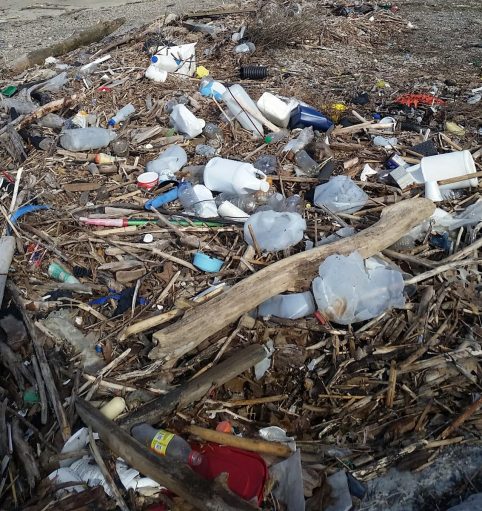
Photo: Lake Erie Land Conservancy
Microbeads
Microbeads are intentionally produced to be used in a variety of products.
The U. S. Microbead Free Waters Act 2015 banned microbeads in “rinse off” cosmetics and over the counter drugs by 2019, including toothpastes, acne scrubs and anti dandruff shampoos. (FDA.gov).
The law doesn’t address all microbeads, which can still be used in deodorants, lotion, sunscreen, nail polish, lipstick, eyeliner and other makeup.
Microbeads flow down household drains to sewage treatment plants or septic tanks.
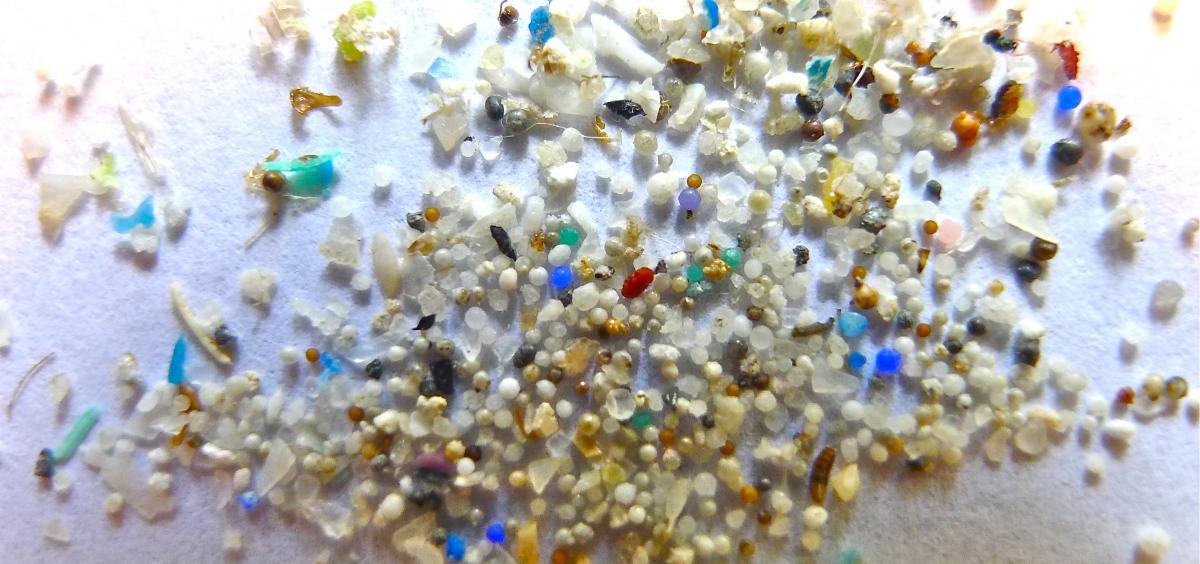
Photo: Oregon State University
Sewage treatment plants
While most of the microbeads and other microplastics are filtered or settled to the bottom sludge, 10% of microplastics remain in effluent released into rivers and lakes. (Iyare et al., 2020; Fuschi et al. 2022)
If microbeads in the bottom sludge (called biosolids) are applied to fields, then they can be carried by stormwater to rivers and lakes.
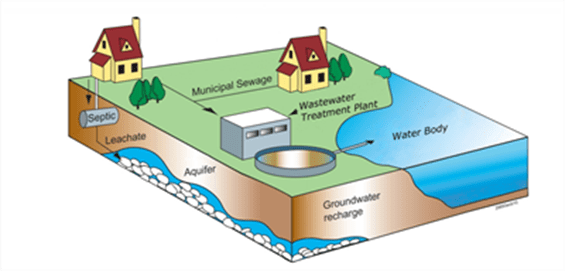
Image: Texas Rural Water Association
Septic Tanks and Drainfields
Some microplastics including microbeads stay in the liquid and are carried to the drainfield
Microplastics in the drainfield can:
- Clog pores in the drain field causing premature failure
- May flow down and contaminate groundwater.
- Microplastics have been found in groundwater. (Casey, 2019)
Some microplastics settle to the bottom sludge of the tank.
Like sludge in sewage treatment plants, when pumped every 3-5 years, can be applied to fertilize fields. Stormwater can carry microplastics away to rivers and lakes.
Microfibers
Microfibers are a type of microplastic released when synthetic clothing is laundered.
A single item of clothing can release 100,000-700,000 fibers in a clothes washer. (Vassilendo, 2021)
Fibers detach from clothes during washing and travel like microbeads in effluent and then into rivers and lakes.
A single clothes dryer can discharge from 1.4 to 40 times more microfibers than from a washing machine.
The dryer discharges microfibers out the vent and into the air. (Tao et al. 2022)
Microfibers are carried by the wind into rivers and lakes.
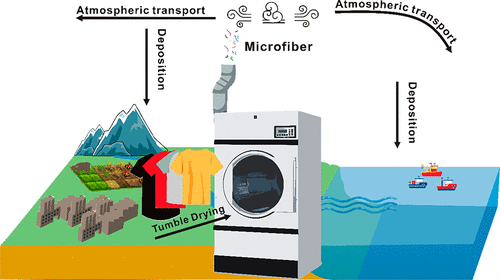
Image: Tao et al. 2022
Plastics and microplastics are transported to lakes by:
- Wind
- Stormwater flowing directly into the lake
- Stormwater flowing through tributaries into the lake
- Stormwater flowing through storm drains into the lake
- Sewage treatment plants releasing effluent into the lake or her tributaries
Did You Know?
Microplastics in People
Humans ingest and inhale microplastics too. The average person consumes up to a credit card’s worth of plastic a week. ( Senathirajah et al. 2021)
Microplastics in Water
Microplastics are found in bottled water and tap water.
Bottled water contains more microplastics than tap water. (Mason et al., 2018; Gambino et al., 2022)
Microplastics were found in 12 brands of beers brewed with Great Lakes water. (Kosuth et al. 2018)
Microplastics Cause Harm in Waterbodies
Microplastics are found in Great Lakes fish. (McNeish et al. 2021; Munno et al. 2021)
Microplastics harm aquatic creatures in 2 ways:
- Ingesting and inhaling foreign plastic fragments
- Poisoning with toxic chemicals
Plastics leach their chemical components into the water or the creature that consumed them.
Plastics also absorb and concentrate toxic chemicals found in water and release them in the creature that has consumed microplastics.
Microplastics can harm small aquatic creatures, not just large ones. (O’Connor, 2018)
Microplastics can impair photosynthesis and growth of small aquatic plants called phytoplankton. (Shen et al. 2020)
After eating microplastics, zooplankton (small aquatic animals that eat phytoplankton) exhibited poor development and reproduction. (Shen et al. 2020)
Fish fed microplastics with toxins absorbed from seawater suffered from liver toxicity and other health issues. (Rochman et al. 2013)
Show
You Care
We know you want to enjoy the lake for many years (and generations) to come. So, we’ve put together a list of simple steps you can take to reduce the nutrients, sediments and toxins flowing into the lake and its streams.
Torch Lake Watershed has high water quality.
Microplastics are a threat to Torch Lake.
Microplastics consist of broken-down fragments of plastic, microbeads and microfibers.
Microplastics CAN NOT be cleaned up once they enter lakes.
Keep microplastics out of Torch Lake.
Lower your plastic footprint.
Avoid Single-use Plastic
Replace plastic with reusable alternatives made of wood, bamboo, metal or cloth.
See True Blue Living for reusable alternatives found in your bathroom, kitchen, laundry room, grocery store and restaurants.
Avoid Microbeads
Avoid buying and using make-up, deodorants, lotions, sunscreens, nail polish and household cleaners that contain microbeads.
Read the label. If the ingredients include polyethylene or polypropylene, don’t buy it. Call the customer service number on the product to ask if the product contains microbeads.
Avoid Microfibers
Change the way you buy clothes.
All materials shed some number of microfibers. But some shed less than others.
Natural sources fibers are larger than synthetic fibers and do not persist as long.
Newer clothes shed more fibers than clothes previously worn and washed ones.
- Buy clothes made from natural materials.
- Buy fewer new clothes.
- Shop vintage and used clothing stores.
| Natural Materials (Buy) | Synthetic Materials (Avoid) |
|---|---|
| Cotton Hemp Linen Silk TENCEL Wool | Acetate Acrylic Lycra (Spandex) Nylon Polyethylene terephthalate (Fleece) Rayon |
Change your laundry practices.
Clothes washers release microfibers into wash and rinse water.
- Wash clothes less often.
- Spot clean by hand instead of washing whole garment.
Use cold water: it leads to less fabric breakdown.
Air dry clothes on a drying rack indoors OR clothesline outdoors.
- Dryers release more microfibers than washers.
Use a front-load washer
- Top loading machines release 7x more fibers compared to front loaders because front loaders use less water and tumbling motion. (Hartline et al., 2016)
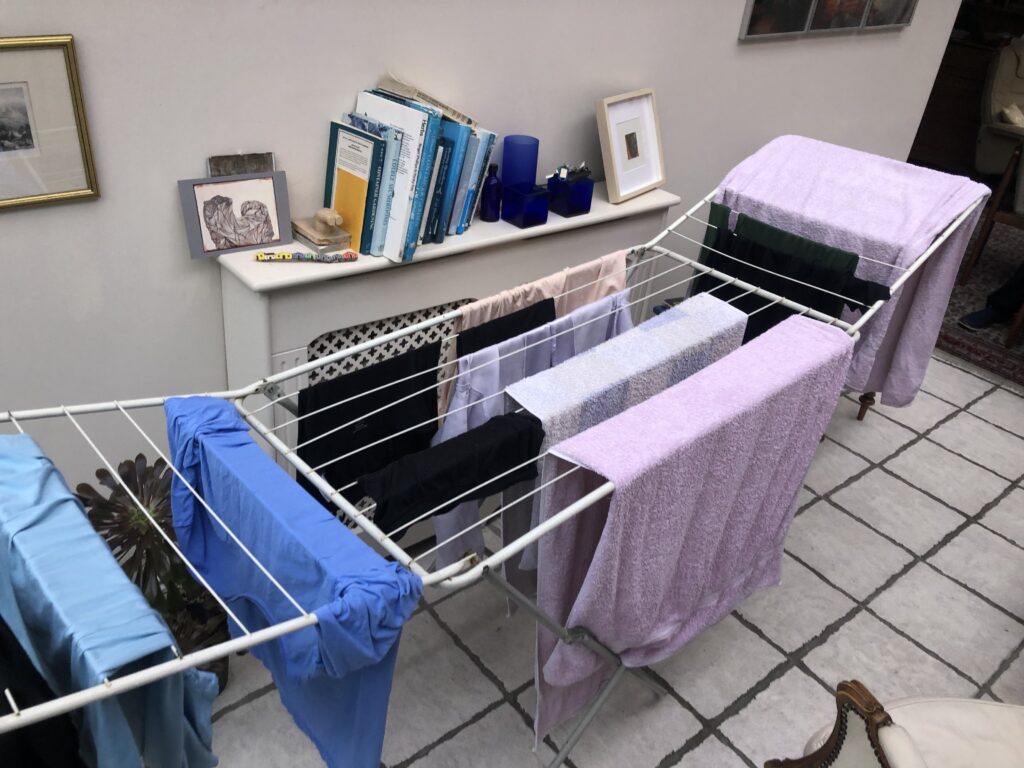
Photo: Torch Conservation Center
Sources:
Casey, A. (2019) New Research Finds Microplastics in Illinois Groundwater. Illinois Public Media
Enck,J. and Dell, J. (2022) Plastic Recycling Doesn’t Work and Will Never Work The Atlantic.
Foley, C. (2023) Microplastics in the Great Lakes: 2023 Ice Breaker Series. Tip of the Mitt.
Fuschi, C. et al. (2022) Microplastics in the Great Lakes: Environmental, Health and Socioeconomic
Implications and Future Directions. American Chemical Society Sustainable Chemistry and Engineering.
Gambino, I. et al. (2022) Occurrence of microplastics in Tap and Bottled water: Current Knowledge.
International Journal of Environmental Research and Public Health
Hoffman, M. and E. Hittenger (2017) Inventory and transport of plastic debris in the Laurentian Great Lakes. Marine Pollution Bulletin
Horton, H. (2023) New Disease caused by plastics discovered in seabirds. The Guardian.
Iyare, P.U. et al. (2020) Microplastic removal in wastewater treatment plants: a critical view.
Environmental Science: Water Research and Technology
Kosuth, M. et al. (2018) Anthropogenic contamination of tap water, beer and sea salt. Public Library of Science (PLOS) One
Law, K.L. et al. (2020) The United States’ contribution of plastic waste to land and ocean. Science Advances Vol 6, Issue 4.
Mason, S. et al. (2018) Synthetic polymer contamination in bottled water. Frontiers in Chemistry
McNeish, R. E. et al. (2021) Microplastics in riverine fish is connected to species traits. Scientific Reports
Munno, K. et al. (2021) Microplastic contamination in Great Lake Fish. Conservation Biology
O’Connor, M. C. (2018) Humans, fish and other animals are consuming microfibers in out food and water. Ensia.com
Parker, L. (2019) The world’s plastic pollution crisis explained. National Geographic.
Rochman, C. M. et al. (2013) Ingested plastic transfers hazardous chemicals to fish and induces hepatic stress. Scientific Reports.
Senathirajah, K et al. (2021) Estimation of the mass of microplastics ingested -a pivotal first step towards
human health risk assessment. Journal of Hazardous Materials
Tao, D. et al. (2022) Microfibers released into the air from household tumble dryer. Environmental Sciences and Technology Letters
Vassilendo, E. et al. (2021) Domestic laundry and microfiber pollution. Public Library of Science (PLOS) One.
WATERpedia: the “One-Stop Shop” for Water Science A-Z
A-E
F-M
N-S
T-Z
Don't just wish that Torch Lake will stay blue.
Choose a water-friendly lifestyle - make a difference!
